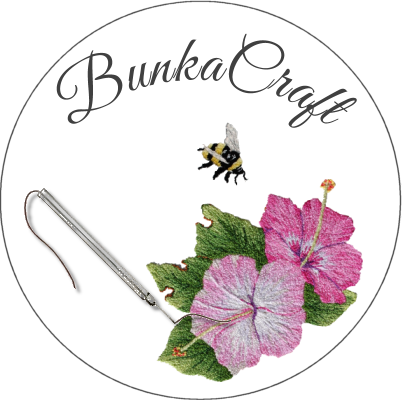Basic Stitches & Techniques
BunkaCraft online videos are designed as easy step by step lessons in the instruction of Bunka Embroidery. Whether you are new to the art of bunka or in need of a bit of a refresher, these short videos provide valuable support and information. Learn Bunka in the privacy of your own home or use the videos as your personal “teacher’s assistant” while away from formal classes.

VIDEO 1:
Before stitching, each skein of thread must be wound onto a thread card. Use a pencil or pen to number the card with the corresponding thread colour. Use one card per skein.

2 – Threading the N3 Bunka Needle
VIDEO 2
Threading the Needle. The parts of the needle: TUBE, GUIDE ( the hole on the side of the tube ), GROOVE ( the opening that runs all the way down the tube ), SHANK ( the “pointy” bit at the bottom of the tube), EYE ( tiny hole at the end of the shank ).
The thread must be INSIDE the entire length of the needle, including the shank and must remain VERY CURLY.
The GUIDE is also the FRONT of the needle and is pointed into the direction of stitching. This ensures that the thread will follow behind the needle when stitching.

3 – Stretching the Fabric – Basic Method
VIDEO 3
Stretching the Fabric: Basic
This method is used primarily in the absence of a key line or border line around the image. For example, Fluffy animal kits. It is important that the fabric be stretched tightly or the stitches may not lay flat or stay in the fabric. The fabric should sound like a “drum” when tapped.

4 – Stretching the Fabric – Plumb Line Method
VIDEO 4
Stretching the Fabric – Plumb Line Method
BunkaCraft Level 1 Sampler
This method of STRETCHING THE FABRIC is used when a key line or border line surrounds the perimeter of the image. It is used to “square” the picture. The plumb line also acts as a first, straight row of stitches. For example, the sky area of a landscape picture would have the first row of stitches placed along the plumb line.
The BunkaCraft Level 1 Sampler is used to learn and practice Bunka Embroidery stitches and techniques prior to using the technique on your kit

5 – Thread Pulls – 1/4, 2/4, 3/4, 4/4
VIDEO 5
Bunka Thread is a 4 ply knitted rayon yarn that is unraveled or “Pulled” before stitching. Rarely, is it used in it’s original form ( known as whole thread or 4/4 pull). On occasion, 1/4 ( which is very thin and fine ) or 3/4 ( which is thicker and forms box – like sections ) is used for more advanced techniques.
Unless otherwise noted, the pull used for most bunka pictures is the 2/4 pull.
In order for the thread to work properly and stay in the fabric, it must remain very curly. Never drag your nail over the pulled thread or wind it too tightly onto the winding card.

VIDEO 6
Basic Running Stitch
This is the stitch that is used in all Bunka Embroidery pictures.
Stitch length in Flat Stitch Pictures is 1/2 – 3/4 inch long. Stitch length for Fluffy Pictures is 1/16 – 1/8 inch long.
Push the needle into the fabric as far as possible. Turn the “Guide” or front of the needle into the direction of stitching. The thread will follow behind the needle.
On the back of the fabric, grasp the thread that runs down the side of the needle and hold the loop. Slowly draw the needle upward toward the surface of the fabric while pulling the thread loop through to the back. Don’t lift the needle above the surface. Lightly scratch the needle tip along the fabric approx. 1/2 inch and push the needle into the fabric using a VERTICAL ANGLE.
To End Stitching: On the back of the fabric, hold the thread on the side of the needle ( loop ). Pull the needle out of the fabric. Don’t let go of the loop. Cut the thread on the front of the fabric approx. 1/4 inch from the surface and pull the thread all the way through the back of the fabric.
Note: Stitch rows using a brick work pattern. Lay the stitches side by side. Don’t overlap, crowd or cross over a stitch. Don’t lift the needle above the surface of the fabric.
Smaller stitches are needed to form curves and circles.

7 – Colour Blending – Basic Method
VIDEO 7
Colour Blending – Basic Method
This video lesson shows the proper way to blend thread colours together.
Jagged or uneven lines indicate an area of colour change – colours are blended together. Use the jagged lines as a reference or guide and follow the colour picture included with the kit for finer detail.

8 – Fluffy – BunkaCraft Level 1 Sampler
VIDEO 8
The following Videos showstitch techniques that are used on the BunkaCraft Level 1 Sampler
Fluffy Technique – BunkaCraft Level 1 Sampler
This technique is used mainly in animal pictures. Although, sometimes fluff areas are used as accents in Flat Stitch Pictures. Remember to complete all “Fluffy” areas first – before beginning Flat Stitch areas.
The Fluffy area is stitched on the back of the picture with very small stitches. After the area is stitched, it is turned over and the loops are brushed out using a “bunka brush”.
Begin by viewing all of the above videos.
1) Wind your thread onto cards. One skein per card and write the thread colour number on the card.
2) Thread your needle using the light green thread
3) Stretch your sampler fabric using the Plumb Line method.
4) Watch this video

9 – Running Stitch – BunkaCraft Level 1 Sampler
VIDEO 9
Running Stitch – BunkaCraft Level 1 Sampler
This is the most basic of all the flat stitches and is used in all Bunka Embroidery pictures.

10 – Running Stitch / Rows – Level 1 Sampler
VIDEO 10
Running Stitch / Rows – BunkaCraft Level 1 Sampler
This video shows the one of the most basic techniques used in Bunka Embroidery.

11 – Row Blending /Line Blending – Level 1 Sample
VIDEO 11
Row Blending / Line Blending – BunkaCraft Level 1 Sampler
This lesson shows how to properly blend colours together. The goal is to have an area of colour change that is subtle.
To achieve delicate blending, don’t overlap or crowd the stitches. Don’t “go around” a stitch or jump over a stitch. Rather, use the following techniques.
1) Lightly scratch the needle with the second colour, into the first colour.
2) When blending, end the stitching inside of the existing colour, leaving a single stitch in the blend area.
3) Stitch into the end or “point” of an existing stitch – rather than “going around” a stitch.
Line Blending:
Use single stitches to soften the colour change. Place single stitches close to the area of change and use the colours that are found in the adjoining area. This is also known as “stitch and cut”.

12 – Wedge Stitch / Line Padding – Level 1 Sampler
VIDEO 12
Wedge Stitches are used to “fill” wide areas in triangular shaped objects; such as flower petals, mountains etc.
Wedges are a single or series of V shape stitches. This technique can also be used to change the direction of stitching.
